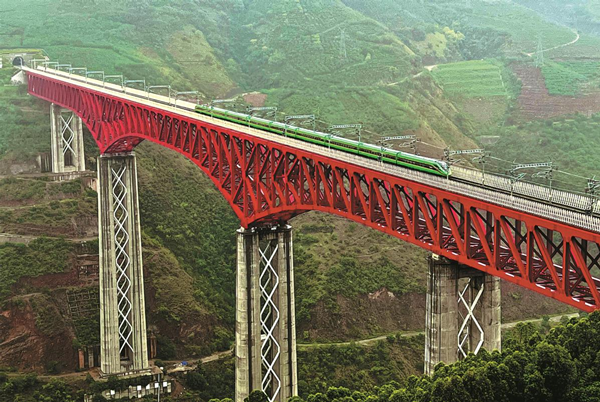
A train crosses a bridge spanning the Yuanjiang River in Yunnan province. The bridge is one of the most important engineering projects on the China-Laos Railway. [Photo by Li Tao/China Daily]
Bullet train service to cut travel time, bring job opportunities
President Xi Jinping, who is also general secretary of the Communist Party of China Central Committee, will meet with Thongloun Sisoulith, general secretary of the Lao People's Revolutionary Party Central Committee and Lao president, via video link on Friday.
The two leaders will also attend a virtual ceremony to jointly witness the opening of the China-Laos Railway, according to Foreign Ministry spokeswoman Hua Chunying.
Santisouk Thebsouphome, 28, a college student from Laos, is now well acquainted with the new line. He used a Chinese bullet train for the first time in 2016, traveling from Kunming, Yunnan province, to Guiyang, Guizhou province.
In addition to the brand-new train cars, which were full to capacity, he was impressed by the high speed of the train, little expecting that in five years, he would become a locomotive driver himself.
The China-manufactured train he will drive-the Lancang-operates on the China-Laos Railway. The new link, which uses Chinese equipment and technology, will help boost bilateral exchanges in various fields from individual to government level.
For many train driver recruits from Laos such as Thebsouphome, the work is challenging.
"None of us had experienced a bullet train before, but after eight months of training, I progressed from being a novice to a capable driver. I was excited," he said.
Thebsouphome studied electrical engineering and automation at Kunming University of Science and Technology from 2011 to 2016.Before that, he knew little about China, apart from the fact that the country bordered Laos.
"During my five years at university, I witnessed China's rapid development and made friends with Chinese classmates. I hope to contribute to my country with the knowledge I learned," he said.
Thebsouphome believes that the railway and electricity supplies are important to Laos' economic and social development. "The railway, in particular, will bring new impetus to the country," he said.
The China-Laos Railway is 1,024 kilometers long and has a top speed of 160 kilometers per hour. It runs from Kunming, capital of Yunnan, passing through a total of 13 passenger and freight stations in the province, before leaving China at Mohan port, heading for Vientiane, the Laotian capital. There are 10 such stations on this line in Laos.
When the line starts operating, passengers will be able to arrive in Vientiane the same day that they leave Kunming, according to the Yunnan Department of Transport.
The department said the new service is a major program conforming to China's Belt and Road Initiative and Laos' aim to "turn a landlocked country into a land-linked country "to promote trade, investment, tourism and cultural exchanges between China and Laos, as well as neighboring countries.
The railway will also help improve transportation in Laos, drive the regional economy, promote poverty reduction and benefit people's livelihoods, the department said.
Thepmoukda Phetsalath, 26, from Laos, said she is looking forward to traveling to China with her mother after the route opens.
After graduating from Tongji University in Shanghai in 2019, Phetsalath landed a job at the Laos-China Power Investment Co, a joint venture in Laos. She did translation and interpretation work while the line's external power supplies were connected.
"The railway will bring great opportunities and convenience to Laotians, and improve our lives," she said, adding she felt honored to contribute to the project.